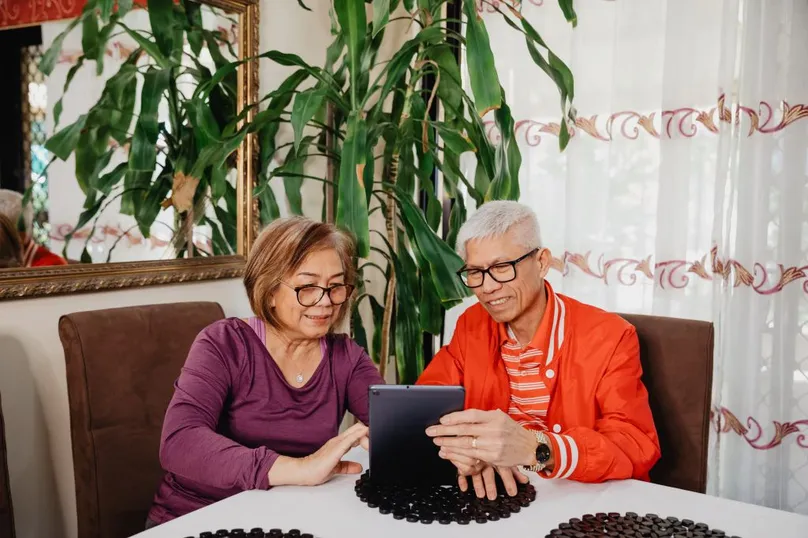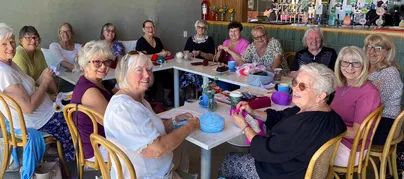Learn about the mental health benefits of decluttering for older people. Here are tips to help you start decluttering your home, so you don’t feel overwhelmed by the process.

The mental health benefits of decluttering
Over the years, you may gather sentimental keepsakes, useful gadgets, and things you might need ‘someday’. But as time goes on, all that stuff can start to pile up, making your home feel cluttered and overwhelming. Research shows that clutter doesn’t just take up space. It can affect your mood, increase stress, and even make daily life more difficult.
The good news? Decluttering is a skill anyone can learn! People who regularly sort through their belongings and let go of what they no longer need feel more in control of their space, experience a stronger sense of home, and enjoy higher levels of mental health and wellbeing.
Clutter can be especially challenging as you get older. It can make it harder to find things, create tripping hazards, and even reduce feelings of comfort in your own home. Some organising philosophies, such as those popularised by Marie Kondo, emphasise the emotional impact of your belongings. They highlight the benefits of keeping only what adds value to your life.
Decluttering isn't just about getting rid of things. It’s also about creating a more peaceful, functional space that supports your mental health.
How to make decluttering easier
Feeling overwhelmed by the monumental task of decluttering a house? Looking for some decluttering tips before you begin? You've come to the right place!
By taking a step-by-step approach, you can make this process manageable. Here are some practical suggestions to help you start decluttering your home.
3 strategies for decluttering your home
While different approaches work for different people, the key is finding a way to declutter your space that feels right for you. Here are 3 popular decluttering strategies.
Embrace the mindset of Swedish Death Cleaning
A growing trend in decluttering is Swedish Death Cleaning, or ‘döstädning’. This practice was introduced by Margareta Magnusson in The Gentle Art of Swedish Death Cleaning. It encourages people to gradually sort through their belongings. This may ease the burden on loved ones in the future. Instead of viewing decluttering as a chore, you can think of it as a way to reflect on what truly matters.
Start by asking yourself. ‘If I were to pass away, would this item be meaningful or useful to my loved ones?’ If the answer is no, it may be time to let it go. This perspective can help you make decisions with purpose and reduce feelings of guilt about parting with your possessions.
Use the Four Box Method
This is a popular strategy in decluttering practices. It involves sorting items into 4 categories: Keep, Donate, Sell, and Discard.
1. Keep
Keep items you actively use, need, or that have strong sentimental value.
2. Donate
Donate things in good condition that someone else could use.
3. Sell
Sell valuable items that online or at garage sales.
4. Discard
Discard broken, damaged, or unusable items. These can be thrown away or recycled responsibly.
This method helps structure the decluttering process and makes decisions easier. As with the Swedish Death Cleaning method, if you struggle to decide, ask yourself if the item is meaningful to you or your loved ones.
In the words of Marie Kondo, ‘Does this spark joy?’ If not, it may be time to let it go.
Declutter one area at a time
Decluttering your entire home at once can be overwhelming. Instead, break it down into smaller, manageable goals.
You can start with one room in your home. Or you can start with one task, such as sorting through your clothes.
Consider making a to-do list for decluttering, with tasks in an order that looks something like this:
1. Clothing
Start with clothes you no longer wear. A good rule of thumb is if you haven’t worn it in a year, donate or discard it.
2. Kitchen
Check for expired food and duplicate appliances. Keep just what you use regularly.
3. Living spaces
Clear out unnecessary furniture, magazines, and decor that no longer serve a purpose.
4. Garage and storage areas
These often accumulate the most clutter. Use the Keep, Donate, Sell, Discard method to sort items efficiently.
Research supports breaking down large tasks into manageable pieces, especially when it comes to decluttering. This approach can help reduce hazards in the home. It can help you create a more future-proof environment.
5. Sentimental items
Save these for last, as they can be the hardest to part with. Take photos of items you want to remember but no longer need to keep physically.
Tips for overcoming emotional challenges in decluttering
Letting go of possessions can be tough, especially when they hold sentimental value. But it can be necessary to do so. Research shows that clutter can affect your anxiety levels, sleep, and ability to focus.
Here are some strategies to help you navigate these emotional challenges
1. Acknowledge the memories, not the items
Keepsakes hold value through your memories, not their physical presence. You can preserve them by taking photos or writing about them. This approach helps you cherish the sentiment without holding onto the item itself.
For a more personal touch, services like Family Tales by Christian Mauri can help document your stories into lasting legacy items.
2. Pass items on with love
If an item holds meaning but is no longer useful to you, think about giving it to someone who will appreciate it.
3. Limit ‘just in case’ thinking
If you haven't used something in years, it's unlikely you'll need it in the future.
Keeping items ‘just in case’ can contribute to clutter. You can stop clutter from accumulating in the first place by avoiding this mindset.
4. Remind yourself of the benefits of decluttering
A clutter-free home leads to less stress, easier cleaning, and a safer environment. Studies have shown that decluttering can improve both emotional and physical health.
Start decluttering today
Remember that decluttering isn’t just about cleaning up. It’s about creating a home that supports your health and makes daily life easier. Reducing clutter and organising your environment can improve both your mental health and overall wellbeing.
Try taking small steps and being kind to yourself throughout the process. You’ll not only reduce stress but also make space for what truly matters.
It doesn’t matter which approach you choose, whether it’s Swedish Death Cleaning, the Four Box Method, or simply starting with one drawer at a time. Every step you take brings you closer to a more peaceful and manageable home.
Here are two simple decluttering tips to keep in mind: start small and start now. Happy decluttering!
Get in touch with LiveUp
For more information on healthy ageing, take the LiveUp quiz or get in touch with one of our helpful navigators on 1800 951 971.
References
Roster, C. A., Ferrari, J. R., & Jurkat, M. P. (2016). The dark side of home: Assessing possession ‘clutter’ on subjective well-being. Journal of Environmental Psychology, 46, 32-41. https://doi.org/10.1016/j.jenvp.2016.03.003
Rogers, C. J., & Hart, R. (2021). Home and the extended-self: Exploring associations between clutter and wellbeing. Journal of Environmental Psychology, 73, 101553. https://doi.org/10.1016/j.jenvp.2021.101553
Magnusson, M. (2018). The Gentle Art of Swedish Death Cleaning: How to Free Yourself and Your Family from a Lifetime of Clutter. Scribner.
Kondo, M. (2014). The life-changing magic of tidying up: The Japanese art of decluttering and organizing. Ten Speed Press.
Aclan, R., George, S., & Laver, K. (2023). Common home hazards among healthy older aged adults and potential modifications required for age-friendly housing. Australian Occupational Therapy Journal, 70(6), 667-676. https://doi.org/10.1111/1440-1630.12918
Royal Australian College of General Practitioners (RACGP). (2021). What does clutter do to your brain and body? https://www1.racgp.org.au/newsgp/clinical/what-does-clutter-do-to-your-brain-and-body
How to use this information
LiveUp provides free information to help you make informed decisions about your health. This information is for general and educational purposes only, is not intended to provide a comprehensive guide, and does not replace medical advice. Everyone is different, so some of these tips may work better for you than others. You should use your own judgment and seek medical advice when applying this information to yourself, to determine if it is suitable in your circumstances. Your use of, or reliance on, this information is solely at your own risk. Independent Living Assessment Incorporated is not responsible or liable for any injury, loss, or damage caused as a result of your use of, or reliance on, this information.
Download and print this article:
You can print out the PDF and stick it to your fridge or file away the tips to revisit at a later time.

Read more Mental Health articles
Did you enjoy this article? You may also like reading similar healthy ageing articles.
See all Mental Health articles

